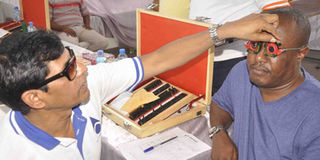Ugandans asked to donate eyes

Examination. Dr Ganesh Prasad Yadav, a consultant optometrist at Agarwal’s eye hospital in Kampala, examines one of the patients who showed up for the eye camp in Mogas Naalya Gas Station on Sunday. PHOTO BY STEPHEN OTAGE.
What you need to know:
Ignorance. An executive member of NICAU says many Ugandans are suffering from visual impairments which they are not aware of
KAMPALA.
The North Indian Community Association of Uganda (NICAU) has asked government to build an eye bank so that Ugandans can be initiated into a culture of donating eyes.
Speaking at their eye camp in Naalya, Kampala on Sunday, Amit Jain an executive member of the association, said many Ugandans are suffering from visual impairments which they are not aware of because of ignorance yet many of these are correctible if professional assistance is sought early.
“We carry out monthly eye camps in slums around Kampala and the turn up is usually overwhelming. Ugandans need to know that most eye diseases are caused by poor hygiene,” he said.
He said common eye diseases like cataracts and in the worst case cornea transplants are caused by poor hygiene.
“Cataracts surgery costs about Shs2 million while a Cornea transplant costs about Shs8 million which most Ugandans cannot afford because we have to import the cornea from USA and Sri lanka since Uganda does not have an eye bank,” he said.
Asked how an eye bank operates and how corneas are made, Dr Ganesh Prasad Yadav, a consultant optometrist at Dr Agarwal’s Eye Hospital, said cornea are harvested from individuals who voluntarily donate them before they die and they are harvested within the first six hours of death.
“In the eye, the lens and cornea are the most important parts. The cornea corrects the amount of light entering the eye and once it is completely destroyed, the only option is seeking a cornea transplant,” he said, adding that with an eye bank within the country, cornea transplant could reduce to less than Shs2m.
“All the cornea we transplant are harvested from dead people because it is a tissue which is not connected to any blood vessel. A cornea can be transplanted from any person to another without a problem,” he said.
The Sunday camp at Mogas Fuel Station in Naalya was organised by Dr Agarwal’s Eye Hospital in conjunction with NICAU where more than 300 residents around Naalya got free eye checks and free spectacles for those who were found in need of them.
How an eye bank works
According to Dharmendra Agarwal, the chairman NICAU, an eye bank works like a blood bank. When a person is still living, that person pledges his or her eyes to the eye bank in writing. When he/she dies, the eye bank comes and picks the eyes from the dead person and removes the cornea to keep it fresh since it is still living. In India, eye donation is a popular practice. In Sri Lanka, it is mandatory for the citizens to pledge their eyes after the government realised that it was spending a lot of money on importing cornea for transplant.
A 2016 global survey on Corneal transplantation and eye banking shows Sri Lanka and USA as the leading countries in eye banking. When contacted, Sarah Opendi, the State minister for Health, said as of now, government has not thought of such an innovation but with a refurbished and a new transformed Mulago hospital, these are some of the things they would like to see in the new hospital. “We have not got to that level but it would be the best thing and since Mulago hospital is being transformed, these are some of the new things we would like to see there, instead of people travelling abroad for expensive treatment,” she said.




